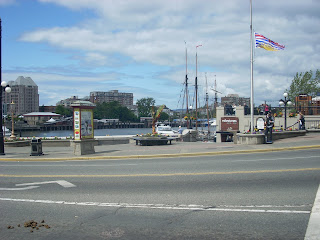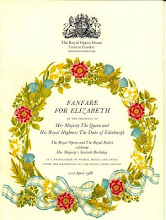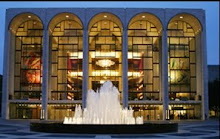Formal Night on Crystal Symphony
seated--Jerry, Mary, Ray
standing-Jean, Myron, Susan
Dinner on Crystal Symphony
Alaska was purchased from the Russian Empire in 1867. The land became an incorporated territory in 1912, and on January 3, 1959, it became the 49th state of the USA. It is the largest state in land area, but it is the least densely populated state.
Ketchikan....Salmon Capital of the World
Before air travel this was the first port for northbound ships. At only 15,000 residents today, it is fourth in size of the Alaska cities. It still thrives on the booming industries of lumber, fishing and tourism. On this visit I eschewed the salmon farms, teepees, totem poles and Eskimos.
The Tongass National Forest, encompassing over 16 million acres in Southeast Alaska, is the largest National Forest in the US. Just north of Ketchikan lies Misty Fjords National Monument with over 2 million acres of pristine rivers and streams, gleaming ice fields, forested mountains, tumbling waterfalls and glacial lakes. There are no roads; it is accessible only by ships and planes. Dense forests shelter wildlife, including bears, deer, moose, wolves and fox. Coastal waters are the play land of seals, sea lions, otters, whales, porpoises and bald eagles.
Cruising Glacier Bay--Gem of the Inside Passage
Even with global warming, about 10 percent of our world is under ice today. Alaska is 4 percent ice. Glaciers form because snowfall in high mountains exceeds snow melt. Tidewater glaciers, those that reach the sea, are formed in only three places on earth: Chile, Scandinavia and Alaska.
Glacier Bay Park includes about 12 tidewater glaciers that calve (break off) into the bay. As water undermines ice fronts and the sun gradually melts the ice, great blocks of the glacier break loose and crash into the sea. The area is experiencing the most rapid retreat of glaciers since the Ice Age. Broken off iceberg chunks may last a week or more, providing perches for bald eagles, seals and other wildlife. During our day-long cruise the naturalist on board announced that we had just witnessed the largest berg, chunk of ice, that he had seen in 15 years of commentary on cruise ships.
Little bird on a piece of floating ice
Juneau--the capital of Alaska--founded in the 1890's by the gold-hungry prospectors of the Gold Rush--Today tourism has become almost as large an industry as government and fishing.
Saint Nicholas Russian Orthodox Church-built in 1894-It is one of the oldest original Russian churches left in Southeast Alaska.
Skagway--Home of the North Wind
Skagway--all bundled up against the cold and wind
Skagway--Can you spot me?
Skagway--The stores intrigued me.
Skagway--In this small town without street lights or gates at railroad crossings every second store was a jewelry shop. This was a drastic change from my 1998 cruise to Alaska.
Skagway--horse and buggy stopped in front of another jewelry shop
Skagway...The trains moved very slowly.
Skagway--another train--A man would stand at the crossing holding stop signs.
Skagway--returning to the ship--Crystal Symphony and snow covered mountains in the background
Sitka--Alaska's Russian and Tlingit heritage
Dominating Sitka's skyline is Mount Edgecumbe, an extinct volcano
St. Michael's Russian Orthodox Cathedral
Alexander Baranof, Chief Operator of the Russian-American Company, defeated the Tlingit natives in 1804. The community quickly grew into an international center of trade, industry and culture. Its warehouses stored a fortune in furs, skins and ivory. Ships from around the world anchored in its protected harbor and loaded Sitka's treasures. This was at a time when Los Angeles was a sleepy Mexican village and San Francisco was a small Spanish mission. Imperial Russia eventually lost interest in the colony as profits from the fur trade dramatically decreased.
Sitka's lumber and fishing industries have continued to sustain the economy. In 1960 Japanese investors built the community's large pulp mill, and tourism has become one of Sitka's main industries.
Cruising the Inside Passage--Alaska and British Columbia
If you are extremely lucky, it may be a sunny day, but it is unlikely that you will go home with a tan. By mid-June and July, the days are the longest of the year. Indeed, you are likely to see the phenomenon known as the midnight sun when the sun sets for only a few hours in the early morning. The route along the inside passage yields the natural beauty of the area as seen from the ship and offers a glimpse of Alaska's vast collection of wildlife: an American Bald Eagle, a Brown Bear or the more dangerous Grizzly Bear, a magnificent Humpback Whale, a distinctive black and white Orca, or rare sightings of a wolf, a moose or some of the other thousands of species that inhabit this area.
Vancouver, British Columbia, Canada
There are flowers everywhere in this beautiful cosmopolitan city. The locals are gracious, friendly and hospitable.
Victoria, British Columbia, Canada
Butchart Gardens, the Butterfly Gardens and the Empress Hotel are famous and popular destinations.
Victoria
Victoria
Victoria Harbor

























































No comments:
Post a Comment